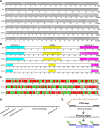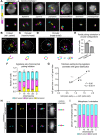Oligopaint DNA FISH reveals telomere-based meiotic pairing dynamics in the silkworm, Bombyx mori
- PMID: 34319984
- PMCID: PMC8351950
- DOI: 10.1371/journal.pgen.1009700
Oligopaint DNA FISH reveals telomere-based meiotic pairing dynamics in the silkworm, Bombyx mori
Abstract
Accurate chromosome segregation during meiosis is essential for reproductive success. Yet, many fundamental aspects of meiosis remain unclear, including the mechanisms regulating homolog pairing across species. This gap is partially due to our inability to visualize individual chromosomes during meiosis. Here, we employ Oligopaint FISH to investigate homolog pairing and compaction of meiotic chromosomes and resurrect a classical model system, the silkworm Bombyx mori. Our Oligopaint design combines multiplexed barcoding with secondary oligo labeling for high flexibility and low cost. These studies illustrate that Oligopaints are highly specific in whole-mount gonads and on meiotic squashes. We show that meiotic pairing is robust in both males and females and that pairing can occur through numerous partially paired intermediate structures. We also show that pairing in male meiosis occurs asynchronously and seemingly in a transcription-biased manner. Further, we reveal that meiotic bivalent formation in B. mori males is highly similar to bivalent formation in C. elegans, with both of these pathways ultimately resulting in the pairing of chromosome ends with non-paired ends facing the spindle pole. Additionally, microtubule recruitment in both C. elegans and B. mori is likely dependent on kinetochore proteins but independent of the centromere-specifying histone CENP-A. Finally, using super-resolution microscopy in the female germline, we show that homologous chromosomes remain associated at telomere domains in the absence of chiasma and after breakdown and modification to the synaptonemal complex in pachytene. These studies reveal novel insights into mechanisms of meiotic homolog pairing both with or without recombination.
Conflict of interest statement
The authors have declared that no competing interests exist.
Figures







Similar articles
-
Chromosome segregation during spermatogenesis occurs through a unique center-kinetic mechanism in holocentric moth species.PLoS Genet. 2024 Jun 24;20(6):e1011329. doi: 10.1371/journal.pgen.1011329. eCollection 2024 Jun. PLoS Genet. 2024. PMID: 38913752 Free PMC article.
-
Centromeric SMC1 promotes centromere clustering and stabilizes meiotic homolog pairing.PLoS Genet. 2019 Oct 14;15(10):e1008412. doi: 10.1371/journal.pgen.1008412. eCollection 2019 Oct. PLoS Genet. 2019. PMID: 31609962 Free PMC article.
-
Synaptonemal complex components persist at centromeres and are required for homologous centromere pairing in mouse spermatocytes.PLoS Genet. 2012 Jun;8(6):e1002701. doi: 10.1371/journal.pgen.1002701. Epub 2012 Jun 28. PLoS Genet. 2012. PMID: 22761579 Free PMC article.
-
Molecular mechanisms of homologous chromosome pairing and segregation in plants.J Genet Genomics. 2014 Mar 20;41(3):117-23. doi: 10.1016/j.jgg.2013.12.003. Epub 2013 Dec 18. J Genet Genomics. 2014. PMID: 24656232 Review.
-
Centromere pairing precedes meiotic chromosome pairing in plants.Sci China Life Sci. 2017 Nov;60(11):1197-1202. doi: 10.1007/s11427-017-9109-y. Epub 2017 Jul 26. Sci China Life Sci. 2017. PMID: 28755295 Review.
Cited by
-
Translocations and inversions: major chromosomal rearrangements during Vigna (Leguminosae) evolution.Theor Appl Genet. 2024 Jan 23;137(1):29. doi: 10.1007/s00122-024-04546-8. Theor Appl Genet. 2024. PMID: 38261028
-
Agent-based modeling of nuclear chromosome ensembles identifies determinants of homolog pairing during meiosis.PLoS Comput Biol. 2024 May 13;20(5):e1011416. doi: 10.1371/journal.pcbi.1011416. eCollection 2024 May. PLoS Comput Biol. 2024. PMID: 38739641 Free PMC article.
-
Chromosome-level assembly of the Rangifer tarandus genome and validation of cervid and bovid evolution insights.BMC Genomics. 2023 Mar 23;24(1):142. doi: 10.1186/s12864-023-09189-5. BMC Genomics. 2023. PMID: 36959567 Free PMC article.
-
The 3D Genome: From Structure to Function.Int J Mol Sci. 2021 Oct 27;22(21):11585. doi: 10.3390/ijms222111585. Int J Mol Sci. 2021. PMID: 34769016 Free PMC article. Review.
-
Co-inheritance of recombined chromatids maintains heterozygosity in a parthenogenetic ant.Nat Ecol Evol. 2024 Aug;8(8):1522-1533. doi: 10.1038/s41559-024-02455-z. Epub 2024 Jul 16. Nat Ecol Evol. 2024. PMID: 39014144 Free PMC article.
References
Publication types
MeSH terms
Substances
LinkOut - more resources
Full Text Sources
Miscellaneous

